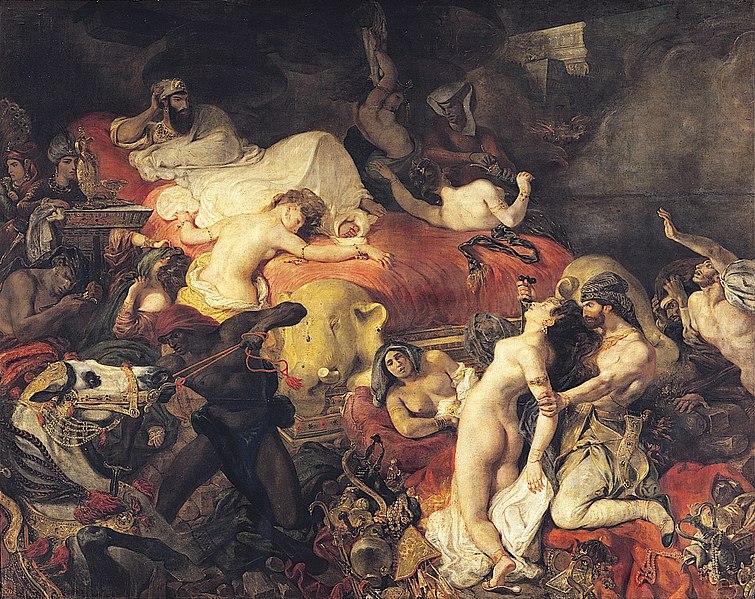Introduction to Romanticism
Romanticism, first defined as an aesthetic in literary criticism around 1800, gained momentum as an artistic movement in France and Britain in the early decades of the nineteenth century and flourished until mid-century. With its emphasis on the imagination and personal emotion, Romanticism emerged as a response to the disillusionment with the Enlightenment values of reason and order in the aftermath of the French Revolution of 1789. Though often posited in opposition to Neoclassicism, early Romanticism was shaped largely by artists trained in Jacques-Louis David’s studio. This blurring of stylistic boundaries is best expressed in Ingres’ Apotheosis of Homer and Eugène Delacroix’s Death of Sardanapalus which polarized the public at the Salon of 1827 in Paris.


While Ingres’ work seemingly embodied the ordered classicism of David in contrast to the disorder and tumult of Delacroix, in fact both works draw from the Davidian tradition, but each ultimately subverts that model, asserting the originality of the artist—a central notion of Romanticism.
In Romantic art, nature—with its uncontrollable power, unpredictability, and potential for cataclysmic extremes—offered an alternative to the ordered world of Enlightenment thought. The violent and terrifying images of nature conjured by Romantic artists recall the eighteenth-century aesthetic of the Sublime. As articulated by the British statesman Edmund Burke in a 1757 treatise and echoed by the French philosopher Denis Diderot a decade later, “all that stuns the soul, all that imprints a feeling of terror, leads to the sublime.” In French and British painting of the late eighteenth and early nineteenth centuries, the recurrence of images of shipwrecks and other representations of man’s struggle against the awesome power of nature manifest this sensibility. Scenes of shipwrecks culminated in 1819 with Théodore Gericault’s strikingly original Raft of the Medusa (Louvre), based on a contemporary event. In its horrifying explicitness, emotional intensity, and conspicuous lack of a hero, The Raft of the Medusa became an icon of the emerging Romantic style. Similarly, J.M.W. Turner’s 1812 depiction of Hannibal and his army crossing the Alps (Tate, London), in which the general and his troops are dwarfed by the overwhelming scale of the landscape and engulfed in the swirling vortex of snow, embodies the Romantic sensibility in landscape painting.

Another facet of the Romantic attitude toward nature emerges in the landscapes of John Constable, whose art expresses his response to his native English countryside. When his landscapes were exhibited in Paris at the Salon of 1824, critics and artists embraced his art as “nature itself.” Constable’s subjective, highly personal view of nature accords with the individuality that is a central tenet of Romanticism.

Along with plumbing emotional and behavioral extremes, Romantic artists expanded the repertoire of subject matter, rejecting the didacticism of Neoclassical history painting in favor of imaginary and exotic subjects. Orientalism and the worlds of literature stimulated new dialogues with the past as well as the present. In its stylistic diversity and range of subjects, Romanticism defies simple categorization. As the poet and critic Charles Baudelaire wrote in 1846, “Romanticism is precisely situated neither in choice of subject nor in exact truth, but in a way of feeling.”[1]
Take note that the emotion of Romanticism differs from earlier styles that evoked an emotional response in the viewer (Baroque art, for example). In this case, it is the personal emotion of the artist that is explored and expressed. For example, Gericault doesn’t paint the dramatic Raft of the Medusa because someone commissioned him. He painted it because he was outraged and wanted to express his personal feelings about it. Similarly, Constable didn’t paint nostalgic images of the English countryside to please specific patrons. He painted scenes of figures in harmony with nature based on his personal experiences with and memories of those locations.
- Galitz, Kathryn Calley. “Romanticism.” In Heilbrunn Timeline of Art History. New York: The Metropolitan Museum of Art, 2000–. http://www.metmuseum.org/toah/hd/roma/hd_roma.htm (October 2004) ↵

